
2.24.24 Summary
S , O NE
I N F I N I T E

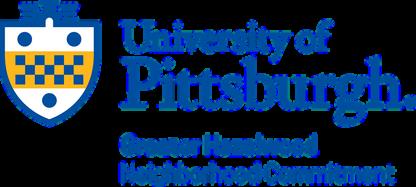
T Y V I S I O N

PERSPECTIVE
COMMUNI

Additional highlights and updates can be found on our Facebook and Instagram profiles, in addition to our website.
Let me extend a heartfelt thanks to the Greater Hazelwood community, The Heinz Endowments, our esteemed community and university partners, and the dedicated members of our project planning team. Your invaluable contributions continue to drive the success of this project.
As we look forward, let us embrace the vibrant possibilities that lie ahead, much like a kaleidoscope, with each turn revealing new patterns of collaboration, innovation, and progress.
With gratitude, Heidi Ward, Director of Planning
Thank you to the community partners who supported this event!
1:11 Juice, Carnegie Museums of Pittsburgh, Carnegie Science Center, Community Kitchen Pittsburgh, DeLoJe, EvolvingSTEM, Greater Hazelwood Historical Society of Pittsburgh, Hazelwood Café, La Gourmandine, Pittsburgh Event Childcare, Tis’ So Sweet, Trailblaze, University of Pittsburgh – Department of Biological Sciences, University of Pittsburgh – Office of Special Events, What Could Be
TABLE OF CONTENTS Contents..........................................2 Introduction....................................3 Project Background......................4 Project Planning Team.................5 Project Engagement.....................6 Springboard Ideas.........................7 Summit Facilitation.......................8 Big Idea Feedback.......................12 Next Steps.....................................
16 Greetings,
2
INTRODUCTION
The University of Pittsburgh’s Office of Engagement and Community Affairs convened the Greater Hazelwood Kaleidoscope Summit on February 24, 2024, at Mill 19 on Hazelwood Green.
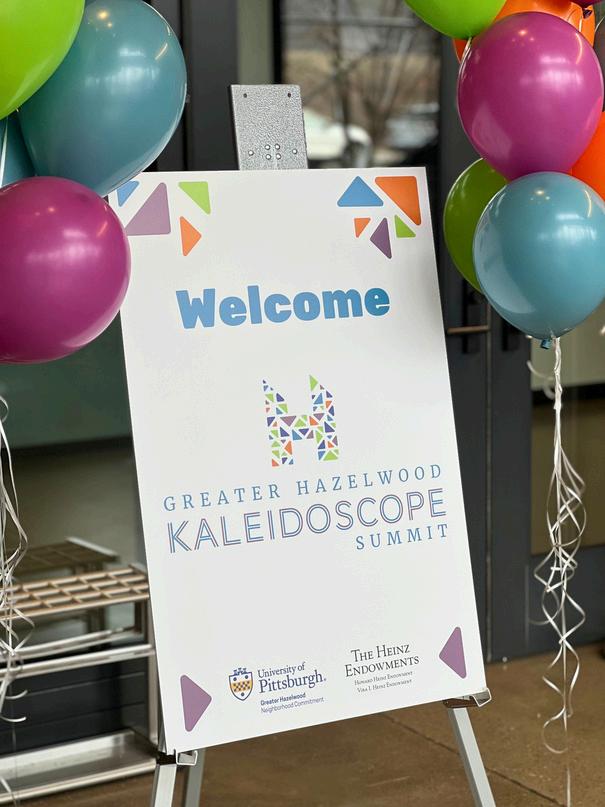

The summit's purpose was to bring together a diverse range of unique perspectives and foster in-depth discussions on how the field of life sciences can positively impact the Greater Hazelwood community. The summit’s goal was to identify the best shared ideas, discuss operational strategies, and connect with people who can move initiatives to action.

Lunch, neighborhood transportation, and childcare were provided. 146 individuals registered for the event, and we welcomed over 100 unique attendees on the day of the summit!
Indoor Summit Welcome Sign
3
Outdoor Summit Welcome Sign
PROJECT BACKGROUND
Greater Hazelwood will be at the center of Pittsburgh’s next major transformation, with Hazelwood Green at the forefront of Pittsburgh’s growth as a regional hub for robotics, advanced manufacturing, and, specific to the University of Pittsburgh, the life sciences industries.
Pitt is leading the development of Pitt BioForge, a cutting-edge biomanufacturing facility in Hazelwood Green, dedicated to advancing cell and gene therapies.
Leveraging this emerging life sciences corridor, Pitt is also committed to deepening its neighborhood commitment by establishing its third Community Engagement Center (CEC) in Greater Hazelwood. The CEC in Hazelwood will have an emphasis on the field of life sciences.
By launching these two catalytic initiatives, Pitt is dedicated to driving momentum for community and life sciences opportunities in Greater Hazelwood and beyond. We are actively working to identify champions and funding sources to support these initiatives.
Learn more about our Greater Hazelwood Neighborhood Commitment by visiting www.community.pitt.edu/hazelwood.

Life sciences is the study of living things like plants, animals, and bacteria—helping us understand how the natural world works, how our bodies function, keys to good health, and much more. The field of life sciences also explores processes like growth, movement, and breathing.
4
Strawberry DNA Extraction Activity
PROJECT PLANNING TEAM
To integrate efforts and maximize impact, we formed a project planning team composed of key community and university leaders. This team has been actively collaborating since November 2022.

Mapping 2/8/23

4/25/23
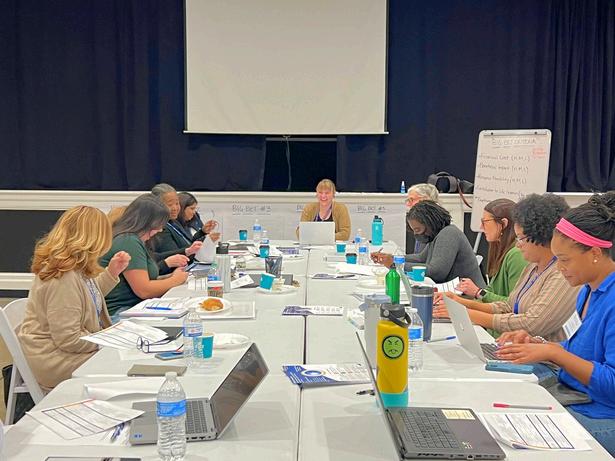
11/6/23
Through a variety of engagement activities— including 51 community meetings and forums, 36 coalition meetings, 23 focus groups and interviews, 15 tabling events and 5 site visits— we engaged in over 130 unique interactions in pursuit of community and life sciences opportunities for Greater Hazelwood.

ProjectPlanningTeam
FirstRow,LefttoRight:SierraMason,JulianaZipay,DanielleDavis,KinseyCasey,DebKillmeyer, TruptiSarode,AbbyHorn,DebbieGallagher,HeidiWard
SecondRow,LefttoRight:GregoryKienzl,KeithCaldwell,BrandenBallard,CassieQuigley,Danielle Chaykowsky,LinaDostilio,SonyaTilghman
5
Stakeholder
Community Impact Tour
Big Idea Evaluation
PROJECT ENGAGEMENT
Like a funnel, our interactions initially yielded a wealth of ideas, which we intentionally worked through to narrow into eight promising springboard life sciences ideas that were presented during the Greater Hazelwood Kaleidoscope Summit.
GreaterHazelwood Opportunities Opportunities
Does the idea leverage the Filter: Does the idea leverage the life sciences to make a positive life sciences to make a positive contribution to the community? contribution the community?
Filter:Whatideawill producethegreatest iimpact? mpact?
Awareness campaign | Mobile laboratory | Healthy homes | Increase walkability | Educational opportunities | Biotech curriculum | Job readiness | Biotech training for educators Round # 1 8 Ideas
Awareness campaign | Spotlight series | Little libraries | Biotech educational seminars | Summits | Collaboration w. PLSA | Science-in-residence office hours | Museum/exhibit | Educational tools | Expand existing non-profit to facilitate a dependable funding stream for community projects | Opportunities to foster community (dinners, walks, health ambassador) | Specialized life sciences degree program | Hazelwood play trail enhancement | Life sciences career map | Workforce ladder study | Continuing education | Teacher fellowship | Pre-apprenticeship | Soft skill development | Small business mentorship | Promote physical activity (gym, esports, riverfront activation) | Saturday programming | Summer camp | Biotech curriculum | Field trips | BioForge site visits | Welcome center | Shared vision for multi-developer site | Micro-shuttle | Inclusionary zoning (IZ) | Housing dashboard | Housing affordability | Establish home ownership | Pedestrian walkway | Sidewalks | GHNP tracking | Universal basic income 37+ Ideas
Ideas Round # 2 Round # 3 Summit
Awareness campaign | Museum/exhibit | Summits | PLSA expansion | Career journey videos | Educational tools | Science-in-residence office hours | Spotlight series | Professional development | Saturday programming | Summer camp | Site visits | Biotech curriculum | Play trail enhancement | Workforce ladder study | Pre-apprenticeship | Small business mentorship | Workforce/housing strategy 18+ Ideas
Determinethebestsharedideasduringthe2.24.24 Summit.Discussactionableplansandchampions.
Round #4 Ideas Round #3 Ideas Round #1 Ideas Round #2 Ideas Filter:
Filter:Whatideawill
GreaterHazelwood
2.24.24 22424 Summit
6
Best
SPRINGBOARD IDEAS
All eight springboard ideas considered alignment with the Greater Hazelwood Neighborhood Plan (GHNP) and were meant to foster discussion and inspiration. Ideas were divided into four priority areas including education, workforce development, community development, and cross-cutting initiatives. Our ideas included:
EDUCATION
EDUCATION
WORKFORCE
WORKFORCE
COMMUNITY DEVELOPMENT
COMMUNITY DEVELOPMENT
CROSSCUTTING CROSSCUTTING
For a comprehensive understanding of each idea, we invite you to explore the Summit program, where detailed explanations and GHNP alignment can be found on pages 8-11.
LIFE SCIENCES EDUCATIONAL OPPORTUNITIES FOR ALL AGES ADVANCE BIOTECHNOLOGY CURRICULUM IN HIGH SCHOOLS B
LIFE SCIENCES JOB READINESS PROGRAM AND NAVIGATION SUPPORT A B A B A B
BIOTECHNOLOGY TRAINING FOR EDUCATORS AND COUNSELORS HOME HEALTH AND WELLNESS INITIATIVES INCREASE WALKABILITY FOR IMPROVED NEIGHBORHOOD CONNECTION LIFE SCIENCES AWARENESS CAMPAIGN MOBILE CAREER DEVELOPMENT LABORATORY
7
A
SUMMIT FACILITATION
Following a detailed introduction and agenda overview, attendees were grouped into one of the four priority areas, with each area further subdivided into table teams of no more than six people. To ensure a diverse range of perspectives, attendees were preassigned to a specific springboard idea. Guests had the flexibility to switch, if they desired.

The aim was to generate momentum for advancing the springboard ideas within a two-hour time frame, involving more than 100 participants' full engagement. What Could Be, a local consultant firm, provided six facilitators.

Each table team:
Reflected on how they already interacted with the life sciences.
Reviewed the assigned springboard idea.
Assessed each idea’s strengths, challenges, improvements, next steps, funding opportunities, and ways to support.
Generated a poster of the best inputs from their table team.


8
Participants in CMU’s training room applause after viewing a project video produced by DeLoJe.
Summit Facilitation Strategy
Participants at the summit collaborate with facilitators to evaluate table team feedback.
SUMMIT FACILITATION
During table discussions, participants filled out a worksheet t assigned idea. The planning team then collected and reviewe worksheets for further evaluation. Worksheets included the following prompts:



Participants assigned to the education priority area gather for a group photo at the Summit.

A completed group worksheet evaluates a springboard idea for community development.
9
SUMMIT FACILITATION
After gathering the best inputs, each priority area used a pres to showcase their posters to the broader group. All posters w



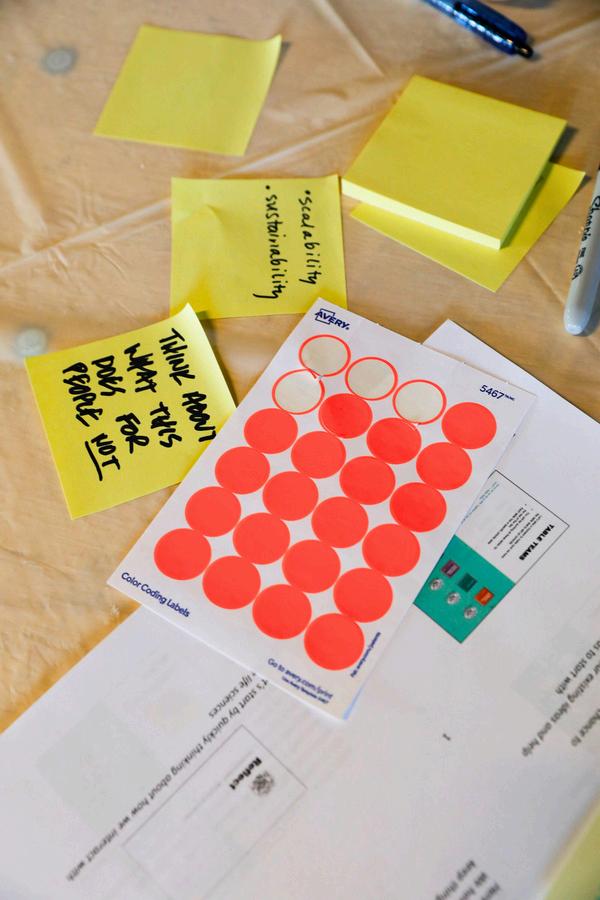
As groups shared the refined ideas, a voting opportunity was held following each presentation. Casted votes allowed the planning team to gauge which ideas had shared momentum among participants.

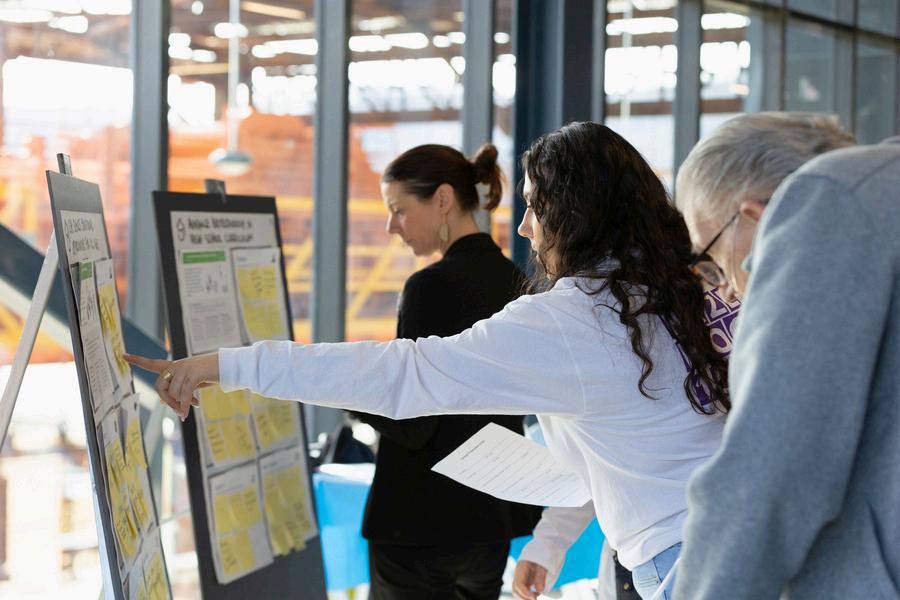
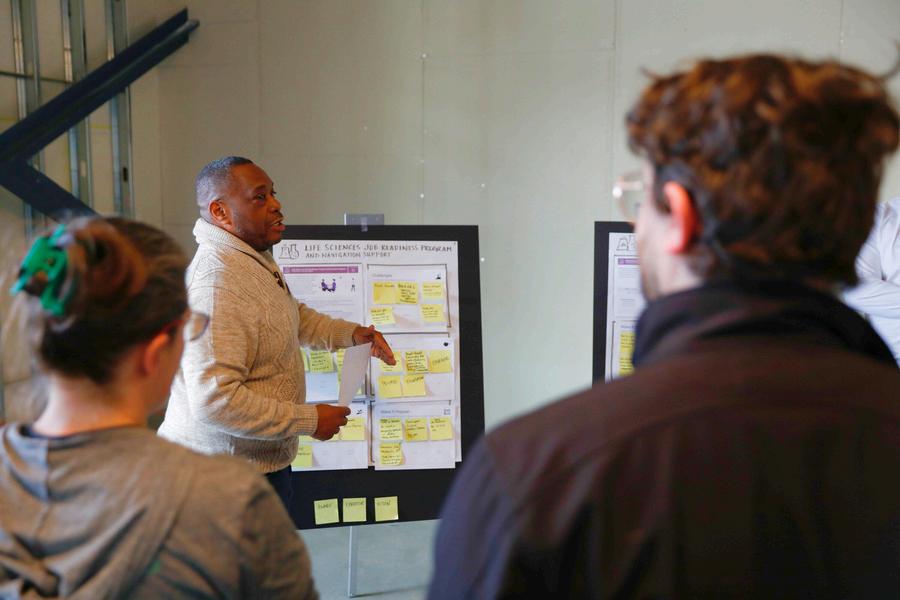
10
Summit participants listen and review poster concepts
Summit participants share their opinion on high interest ideas with a sticker voting system.
SUMMIT FACILITATION
The highest ranking ideas from the Summit were:
Life Sciences Educational Opportunities for All Ages

Increase Walkability for Improved Neighborhood Connection
Mobile Career Development Laboratory
Life Sciences Job Readiness Program and Navigation Support
Home Health and Wellness initiatives
Reminder: All eight ideas, including those with fewer votes, will continue to be revised and pursued as opportunities arise.
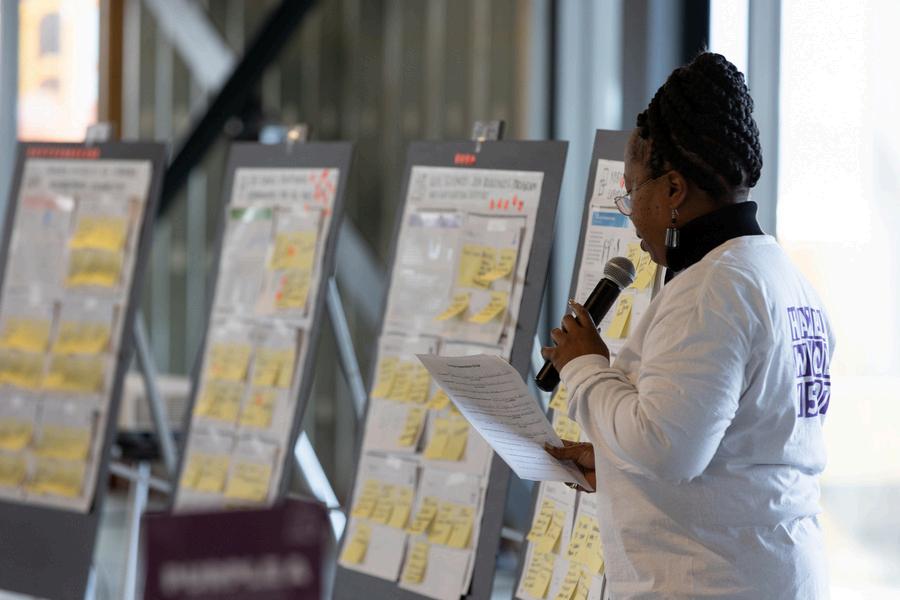

After the group exercises, participants enjoyed lunch and had a chance to explore hands-on life sciences concepts. Attendees were invited to extract DNA from strawberries, view petri dishes of bacteria under a microscope, and explore how T-cells attack infections with a puzzle matching game.
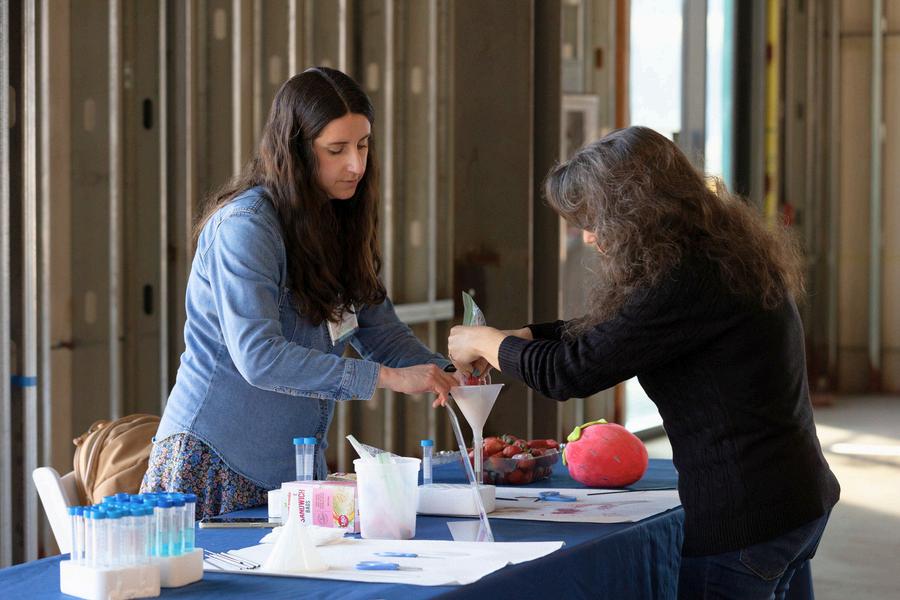
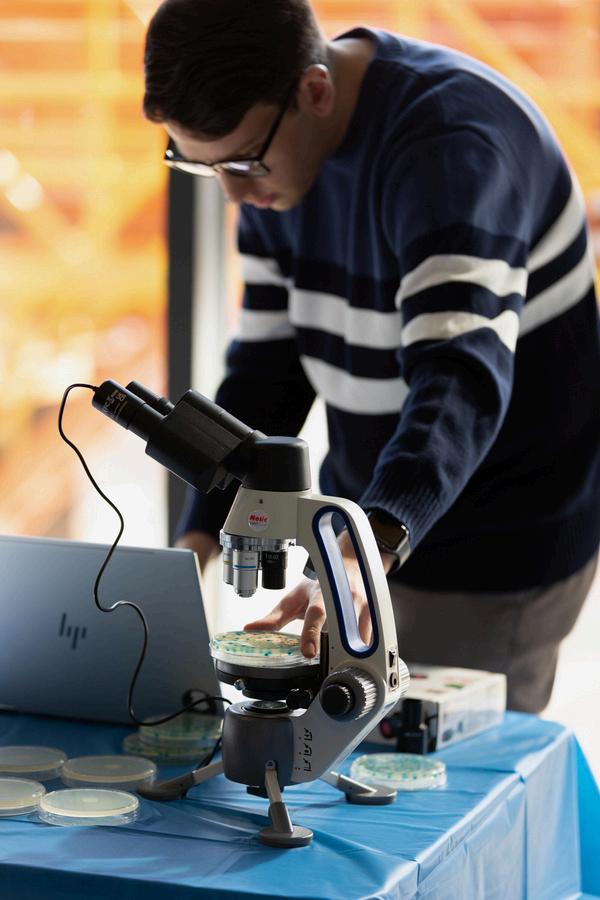
11
Participants present the refined, high interest ideas to the entire group.
Pitt’s Department of Biological Sciences leads a Strawberry DNA extraction activity EvolvingSTEM, a non-profit organization, sets up a petri dish to be viewed under a microscope
BIG IDEA FEEDBACK
LIFE SCIENCES EDUCATIONAL OPPORTUNITIES FOR ALL AGES
Suggestions from Summit Participants
Create a structured, educational framework with objectives. Create a learners pathway that builds at each level.
Build and enhance existing curriculum and programming.
Ensure transportation is available to/from the host site. Consider hosting out-of-school programs at the library.
Provide engaging & hands-on curriculum. Make it relatable.
Ensure materials and curriculum are accessible for all abilities. Create a newsletter.

INCREASE WALKABILITY FOR IMPROVED NEIGHBORHOOD CONNECTION
Suggestions from Summit Participants
Determine priority areas. Target arteries and gateways.
Place an emphasis on improving sidewalks and street lighting by utilizing a ‘complete street design’.
Create clear and connected signage (directional, historical, & safety). Tell all aspects of Hazelwood’s rich history. Safety is a critical factor in determining whether people will actually choose to walk in that area. Include call boxes. Start a walking group!

LONG 5-10+ YEARS
A N T I C I P A T E D T I M E L I N E
MEDIUM 3-5 YEARS 12 High Ranking Idea High Ranking Idea
BIG IDEA FEEDBACK
HOME HEALTH AND WELLNESS INITIATIVES
Suggestions from Summit Participants
Create a survey of needs for residents who need something fixed. Move from research to action.
Organize information sessions and a resource fair to educate residents about home hazards. Solutions not punishment. Form a working group with existing stakeholders. Incentivize landlords to make the improvements. Have alternative housing options while repairs are being made. Use food preparation/storage as an advocacy tool. Link home improvement to workforce development. Distribute air monitors and air filters as a quick first step. Address abandoned buildings for long term solutions.

MOBILE CAREER DEVELOPMENT LABORATORY
Suggestions
from Summit Participants
Consider partnering with another entity who is already doing this type of work.
Build on existing assets for continuation of services outside the mobile lab.
Find out more information about licensing and business certifications.
Consider accessibility for those in a wheelchair. Clarify programming and workforce pathways so there is less chance of overlap.
Connect with mentors in the field. Include intergenerational learning.

13 LONG 5-10+ YEARS
MEDIUM 3-5 YEARS
A N T I C I P A T E D T I M E L I N E High Ranking Idea High Ranking Idea
BIG IDEA FEEDBACK
LIFE SCIENCES JOB READINESS PROGRAM AND NAVIGATION SUPPORT
Suggestions from Summit Participants
Start younger (ages 14-18) with a two-generation approach.
Ensure training is paid. Employer funds the program. Remove barriers (childcare, mental health, housing, etc.).
Guarantee interviews upon graduation from program.
Connect workforce to sustainability/green efforts.
Lean on Universities for design and implementation.
Provide trauma-informed education.
Consider language barriers.
Include local business support.

LIFE SCIENCES AWARENESS CAMPAIGN
Suggestions from Summit Participants
Go beyond awareness. Clarify the call to action.
Determine the specific outputs of the BioForge. Meet people where they are; bus stops, buses, billboard spaces, and local ads (print/digital).
Elevate local voices by engaging people in messagingshare individual stores.
Parts of a campaign could be monetized for funding needs (i.e. an admission fee).
Link to health sciences and community needs. Design proposals for public spaces.
Partner with local artists. Make it interactive.

14 SHORT 0-3 YEARS SHORT 0-3 YEARS A N T I C I P A T E D T I M E L I N E High Ranking Idea
BIG IDEA FEEDBACK
BIOTECHNOLOGY TRAINING FOR EDUCATORS
Suggestions from Summit Participants
Nest within the ‘Life Sciences Educational Opp’ big idea.
Need school district partnership to help with implementation.
Make content relevant/use lived experiences.
Define professional development; offer stipend.
Consider bi-directional learning (knowledge flows from teachers to students and students to teachers).
Overcome barriers to participation and accessibility.
Offer different delivery methods in different locations at different levels.
Make interactive.
Incentivize credentials.
Consider mentorship programs.
Need for K-12 capacity building.

SCHOOL CURRICULUM
Suggestions from Summit Participants
Nest within the ‘Life Sciences Educational Opp’ big idea.
Start curriculum earlier (K-8).
Need support from administration and school district.
Offer support services.
Offer scholarships and the option to earn college credit.
Connect to pre-service teacher education.
Educate parents leading to generational engagement.
Make content relevant to everyday life.
Let students decide what they want.
Integrate skill building.
Make it project based learning.
Consider field trips.
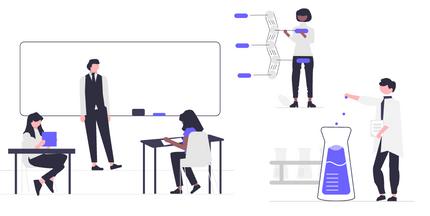
ADVANCE BIOTECHNOLOGY
IN HIGH
15
SHORT 0-3 YEARS MEDIUM 3-5 YEARS A N T I C I P A T E D T I M E L I N E
NEXT STEPS
This summary will continue to serve as our compass as we navigate the transition of our springboard ideas into actionable strategies in the forthcoming months.
Additional time will be necessary to explore potential leads and conduct follow-up discussions, particularly regarding funding and the initiation of pilot programs with identified champions.
For more detailed information about the Greater Hazelwood Kaleidoscope Summit, please visit our website at: www.community.pitt.edu/KALEIDOSCOPE.
We invite all summit participants and newcomers to the project to take a brief survey to share valuable feedback.

www.community.pitt.edu/summitfeedback
All entries received by May 31, 2024 will be entered into a raffle to receive (2) one-time admission tickets to the Carnegie Museums of Art and Natural History.

www.community.pitt.edu/hazelwood
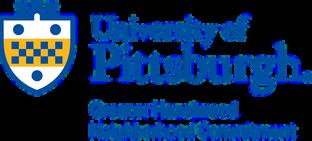

16








































